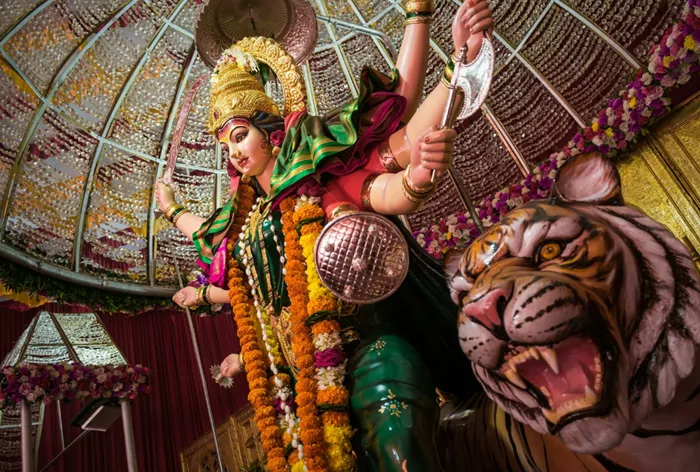As the Hindu fall festivals approach, including Diwali, Dussehra, and Durga Puja, worshipers worldwide prepare by purchasing flowers for ritual worship in temples, outdoor ceremonies, and home altars. Markets across India are bustling with vendors selling freshly cut marigolds, roses, and lotus flowers. Devotees offer these flowers and garlands to deities like Lakshmi, the goddess of wealth, Ganesha, the remover of obstacles, and Durga, the warrior goddess.
At the Sri Venkateswara Temple in Tirumala, southern India, an impressive three tons of flowers were used during a floral bath and procession ceremony in 2024. The high demand for flowers has led to innovative solutions, such as a subscription service started in 2019 by sisters Yeshodha and Rhea Karuturi in Bengaluru, providing fresh flowers for puja or ritual worship throughout India.
Hindu scriptures identify flower offerings as one of the 16 “upacaras” or “services” to the divine. In temple rituals, priests, known as pujaris, place flowers at the feet of the deity or drape them in garlands around the idol’s neck. Flowers are also positioned on a puja table with their stems facing the devotees.
As a scholar of South Asian religions, I note that the “Puranas,” religious texts likely composed between the second and tenth centuries, explain why certain flowers are favored by gods and goddesses. The Puranas, which can be loosely translated to “Old Tales,” narrate stories of Hindu deities, kings, queens, sages, and cultural heroes.
Pleasing the Deities
In her research on Sanskrit ritual manuals in central India, Indologist Gudrun Buhnemann highlights the elaborate rules devotees follow regarding flower offerings. For instance, basil is favored by the god Vishnu but should never be given to Ganesha. Similarly, Lord Shiva accepts offerings of wood apple leaves but does not want them from Surya, the Sun.
The “Skandha Purana,” the longest Purana with approximately 81,000 verses, focuses on Skandha, a son of Shiva and Parvati. This text ranks flowers in terms of their importance, stating that the jasmine, or “jati” flower, is the most superior for worshiping Vishnu. According to the text, a person who offers a garland made of a thousand jati flowers will dwell in Vishnu’s heavenly realm for billions of ages.
In her classic study, “Offering Flowers, Feeding Skulls: Popular Goddess Worship in West Bengal,” religion scholar June McDaniel discusses the worship of Kali, the protective mother goddess, who is adorned with red hibiscus flowers. Red flowers are generally considered sacred to Kali.
The “Shiva Purana” outlines specific flower offerings for worshiping Shiva. Those seeking wealth should offer lotus, chrysanthemum, or marigold flowers. Worshiping Shiva with 100 flowers is believed to enhance wealth and absolve sins.
Flowers that Displease the Gods
The Puranas also specify which flowers should not be offered, as they may displease the deities. For example, red flowers like plumeria and flowers from the screw pine tree are prohibited for Shiva. The Shiva Purana explains the story behind the ketaki, or screw pine flower, which should never be offered to Shiva.
According to the legend, gods Vishnu and Brahma once debated who was superior. To resolve this, they encountered a shaft of blinding light. Vishnu transformed into a boar to dig into the earth while Brahma flew upward on a goose to search for its source. Unable to find the light’s origin, Vishnu returned empty-handed. However, Brahma encountered a ketaki flower and convinced it to falsely claim he had reached the top.
Shiva, emerging from the light, cursed Brahma and the ketaki flower for their deceit. As a result, Brahma would have few devotees, and the ketaki flower would be banned from Shiva’s worship. However, Shiva later relaxed the curse, allowing the ketaki to be used during Mahashivratri, leading to increased demand and higher prices for the flower during this annual festival.
In the “Bhagavad Gita,” another important Hindu text, the type of flower offered is secondary to the devotee’s sincere intention. Krishna states that he accepts any offering made with genuine devotion, whether it be a leaf, flower, fruit, or water.
Lotus for Lakshmi
During the upcoming fall holidays, devotees will honor various deities, including the mother goddess, with flowers and rituals. One of the most significant deities will be Sri Lakshmi, the goddess of wealth and good fortune. Lakshmi is often depicted seated on a lotus throne and holding a lotus in her hand. This flower, which blooms above muddy water, symbolizes purity, prosperity, and spiritual enlightenment.
As devotees welcome Lakshmi into their homes during Diwali, the festival of lights, they will offer her the lotus flower, her favorite offering.
Related topics:
- Rescued by Plant Heritage: Two Former At-Risk Plants
- Avoid Buying a House if You Spot These Plants in the Yard
- Asters: The Perfect Way to Add Color to Your Autumn Garden


